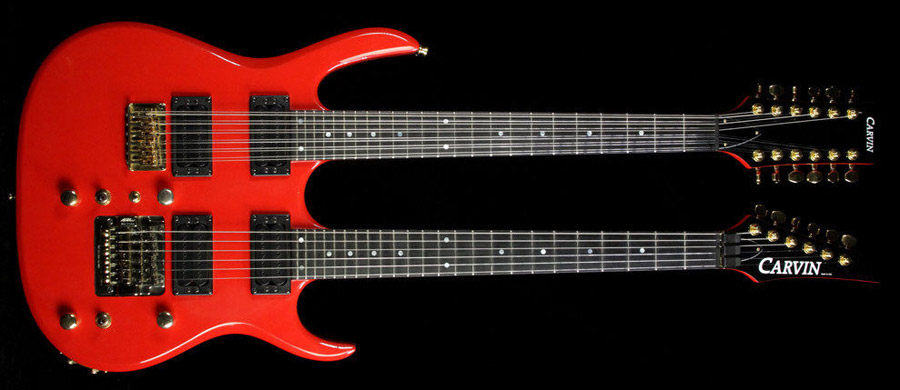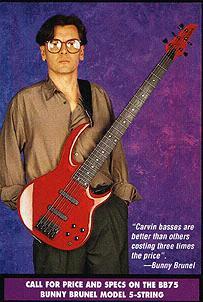
The SH body style was no longer standard on the DC145, but it was still offered as an option on any DC200-style guitar. Also, the DC150 was officially retired, but the DC150 body was offered as an option on other DC200-bodied guitars. The Kahler Pro tremolo was also offered again, and the new standard bridge was the FT6 fixed bridge. The addition of Sperzel locking tuners meant that a locking nut was no longer needed on guitars equipped with tremolos, but it could still be ordered as an option. Sperzels were available in gold, black and chrome, and could also be purchased separately. Also in 1992, quilted maple tops were added to the available list of wood options. This one feature would prove to be one of the most popular optional items Carvin would offer during this era. In addition to the M22N, M22T and M22SD, a new pickup was added for 1992, the M22V. This pickup was designed for the neck position, and had a sound similar to a '59 PAF. Red pickup bobbins were also offered for the first time.
The DC125, like all Carvins in 1992, got a new headstock shape. As in 1991, the body was poplar, with rock maple neck-thru construction and ebony fingerboard with MOP dot inlays. Base price on the DC127 remained $469, or $569 with Carvin Floyd Rose tremolo. The HC10 case was $70. The DC125 in the catalog was Ferrari Red, with Carvin Floyd Rose tremolo, red M22SD pickup and black hardware.
Except for the new headstock and FT6 bridge, the DC127 was unchanged from 1991, although the M22N pickup was replaced with the new M22V. The DC127 remained priced at $519, or $619 with tremolo. The catalog showed a DC127 in Electric Green with black hardware and Carvin Floyd Rose tremolo, and one in Sapphire Blue with black hardware and FT6 fixed bridge.
The DC135 was unchanged, using the same electronics and construction of it's predecessor. The base price of the DC135 held at $569, or $669 with tremolo. The catalog photo showed a DC135 with tung-oiled koa neck & body, Carvin-licensed Floyd Rose tremolo, and gold hardware.
The Ultra V and X220 remained unchanged (except for the new headstocks), and was given a similar two-page spread as in 1991. The X220 also got coil splitters as a standard option for this year. This was the last full year either model would be offered, although the Ultra V would still be in the 1st quarter catalog on 1993. Base price on the Ultra V was unchanged at $529, or $629 with tremolo. The X220 was also priced the same, at $569, or $669 with tremolo. The HC19 hardshell case for either was $80.
The DC200, DC120 12-string and DC400 were essentially the same as 1991, although the DC400 got the new M22V pickup in the neck position, and an M22T in the bridge position. Base price on the DC200 was still $669 ($769 with tremolo), and the DC120 rose slightly to $769. The DC400 dropped to $1099 ($1199 with tremolo). The catalog showed the DC120 in black with gold hardware, DC200 in gloss koa with gold hardware, and the DC400 was shown in Emerald Green on quilted maple with tremolo, reverse headstock and gold hardware, and flamed Sapphire Blue with tremolo and black hardware.
The DC145 changed significantly in 1992. It no longer sported the "SH" rounded body option as a standard feature. The reverse headstock
was still standard, but a standard headstock could be ordered. Electronics consisted of black pickups - an M22V, M22T and H60N. Base price on
the DC145 was unchanged at $599, or $699 with tremolo. The catalog showed a DC145 in Jet Black with black hardware and tremolo, and in Pearl Blue
with black hardware, tremolo, an optional inline headstock.

The DN612 6/12 string doubleneck and the DN640 4-string bass/6-string guitar doubleneck (not shown in the catalog) were unchanged from 1991, but the 12-inline headstock was dropped as an option. Traditional headstocks were standard, but 6-string inline headstocks, as well as 4-string bass inline headstocks, were offered. As in previous years, only the DN612 was shown, not the DN640 or DN440 doubleneck bass. The price remained the same, at $1399 for any model, Plus $90 for the HC15 case. The DN612 shown in the catalog was Jet Black with chrome hardware.
Santa Ana store promo video, circa 2006.
1992 basses would also see Sperzel locking tuners replace the Carvin-brand tuners that had been in use for several years, and a new headstock design, which allowed for straighter string pull, and was less Jackson-seque. The H50B pickups were replaced with the new H50N, which provided a fuller tone and extended top end. 1992 was also the first year for tyhe LB76 6-string bass; a natural progression from the popular LB75. Finally, a "mystery photo" would suggest things to come...
As in previous years, and year to come, the LB20 and LB70 were basically the same instrument, with the LB20 being a passive bass and the LB70 being active. These models, with their now-expanding features and options, remained the same as '91. Base price on the LB20 was $519, and the LB70 was $599 - both of which were the same as '91. The HC17 hardshell case was $80. The catalog photo showed an LB20F in Classic White with black hardware, and an LB20 in Pearl Blue with chrome hardware.
Cosmetically, the '92 LB75 was almost the same as the current model. The major exception was the 3 X 2 headstock, although the '91 5-inline headstock could be ordered as an option. The base price on the LB75 was $669, a slight increase over '91. The catalog photo showed an LB75F with fretlines, koa body wings and gold hardware, and an LB75 in Jet Black with black hardware.
1992 would see a completely new model added to the line up. This was the LB76, Carvin's first 6-string bass. This featured the same string spacing as the LB75, making the transition from 5 strings to 6 relatively easy. This was the first Carvin bass to show a quilted maple top, versus the AAA flamed maple tops that had been shown in previous years. Interestingly, quilted maple was not listed in the available options in the '92 catalog. The base price of the LB76 was $799, and it was available with all the options of Carvin's other basses, including lefty and fretless versions. The catalog showed an LB76 in clear quilted maple with gold hardware and matching headstock, and an LB76 in Sapphire Blue on flamed maple with black hardware and matching headstock.
 An interesting photo was shown on the bass endorser page. Without fanfare, Carvin was announcing it's first-ever signature
instrument (the Holdsworth guitar was still 4 years away). This was the BB75, created in conjunction with longtime Carvin
endorser and bassist extraordinaire Bunny Brunel. And what you see here is all there was regarding this model. A picture,
and a request to call for more information on specs and pricing. Clever marketing ploy, or was it just not ready for production when the catalog went
to press? Either way, it was an unusual introduction - but understandable in the pre-internet era - for an instrument that was destined to become one of Carvin's most popular bass models of the
90s and 2000s. The BB75 would get the full catalog treatment in 1993.
An interesting photo was shown on the bass endorser page. Without fanfare, Carvin was announcing it's first-ever signature
instrument (the Holdsworth guitar was still 4 years away). This was the BB75, created in conjunction with longtime Carvin
endorser and bassist extraordinaire Bunny Brunel. And what you see here is all there was regarding this model. A picture,
and a request to call for more information on specs and pricing. Clever marketing ploy, or was it just not ready for production when the catalog went
to press? Either way, it was an unusual introduction - but understandable in the pre-internet era - for an instrument that was destined to become one of Carvin's most popular bass models of the
90s and 2000s. The BB75 would get the full catalog treatment in 1993.